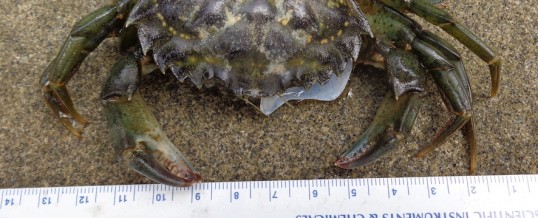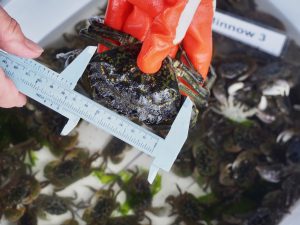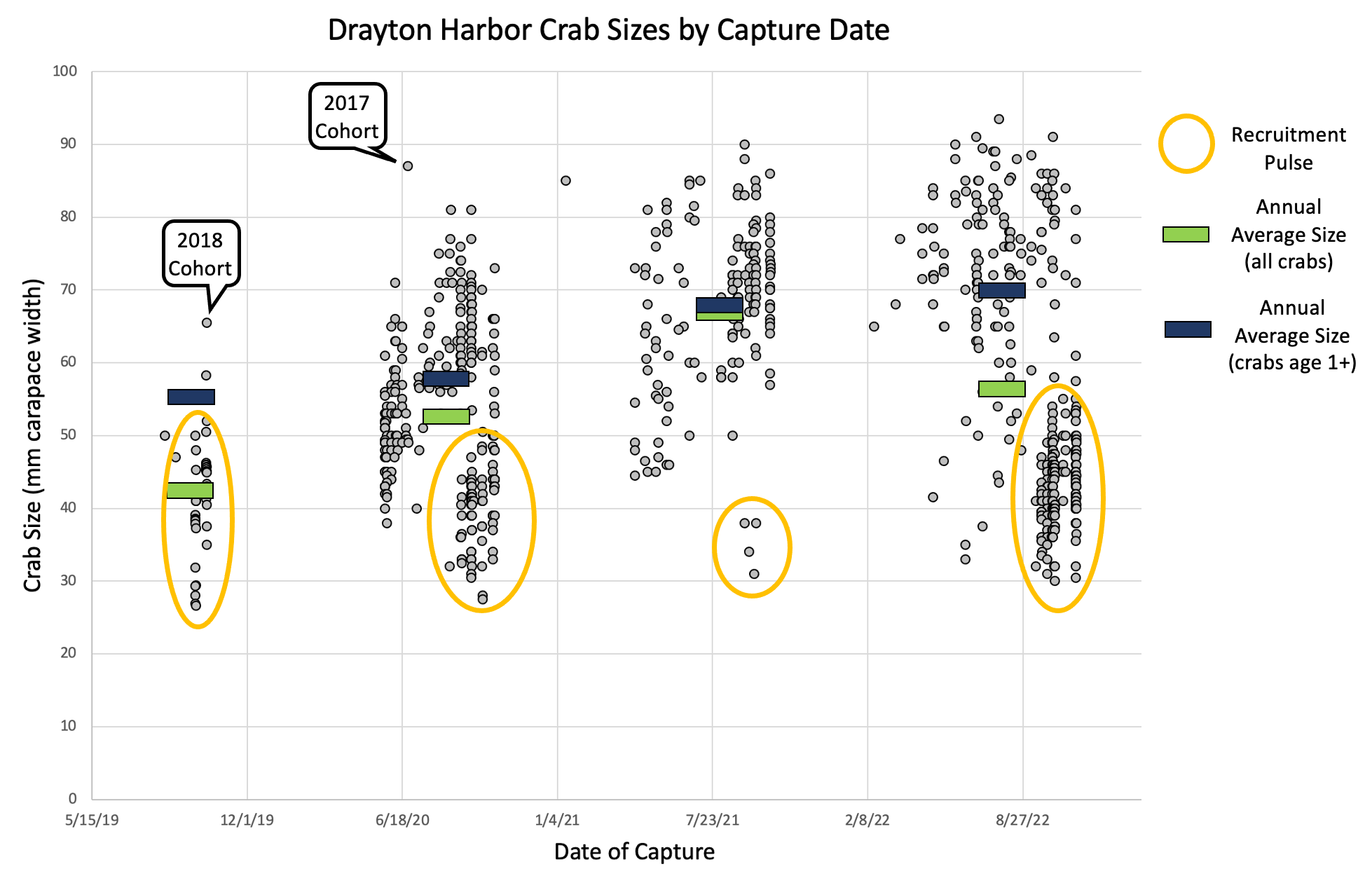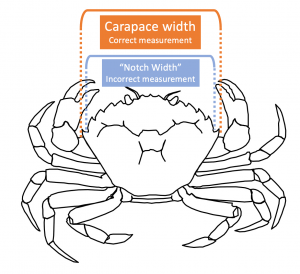
November 17, 2023
We are Crab Team after all, so it’s perhaps no surprise that we are not shy about getting up to our elbows in details about the crabs we catch. But what can we actually learn from looking at size data of crabs? What makes handling all the angry pinchers worthwhile?
We’re covering this rich topic in two issues of Protocol in Focus. This time, we’ll shed light on what we can learn about European green crabs, individually, and as a population, from their measurements. Next time, we’ll cover what we learn from measuring native crab species as well.
What does size tell us about green crabs?

A volunteer from Kala Point measures a European green crab captured in 2018. Photo credit: Wendy Feltham
Regardless of species, the size of crabs is a window into their age, their experience, as well as their ecological role at the site. Crabs, like all molting arthropods, increase in size at a step-wise rhythm, undergoing a nearly immediate “jump” each time they molt. That means that while we might estimate an average curve for the relationship between size and age, there can be a bit less certainty about whether to assign green crabs to one year class or another, depending on which side of one of those jumps we think an individual crab might be on, and we often use other clues like shell color and condition to help make the call. As crabs age, their growth rate slows, and the “jumps” in size gets smaller, so the growth curve flattens making it harder to be sure about the age of older crabs. For green crabs, we have the most confidence in aging crabs from 0-2 years or so, but it’s very hard to assign an exact age to the crabs after they grow above about 60mm. From looking at the size/age of crabs, we can learn about:
- Invasion timing: Because green crabs don’t migrate very far as adults, unlike long-legged Dungies, size enables us to tell roughly how long an individual crab has been living at a site. In some cases this can enable us to establish when green crabs likely first arrived at a site, even if we don’t detect them there until a year or two later.
- Population structure/establishment: Looking at the range of green crab size classes that are present at a site tells us about the “population structure.” That is, how old are the oldest crabs? What is the mixture of different ages present? Together with invasion timing, having a mix of size classes present might indicate that green crabs have become more “established” at a site. It’s important to note, however, that we still can’t confidently tell from size data alone whether an individual green crab was the result of local reproduction, or hatched out at another location and was washed in as a larva to a given site.
- Population forecasting: Each year, as the new cohort of “young-of-the-year” crabs grows large enough to start being captured in traps, we are able to get an estimate of how successful reproduction of green crabs was over the prior year. If we see a huge boom of small crabs show up, we know we will likely need to keep trapping heavily to draw down that year-class. Conversely, in years we might have had some help from nature, like a very cold winter, we might see very limited evidence of juvenile survival, which would in turn result in lower catches the following year.
- Predation/competition impacts: Larger crabs typically have larger claws and are able to handle and consume larger prey (e.g., Lee and Seed, Sanchez-Salazar et al. 1987). Of course, this isn’t always the case, and some larger crabs have at least one claw that’s been lost or is in the process of regrowing following a previous injury. We also collect observations of limb damage on green crabs to give us a more nuanced picture of their likely impacts.
Watching an invasion through the size of its crabs
Crabs can’t talk, but size is the next best thing, it’s one of the most informative parameters that can be gained from the crabs themselves. Without knowing something about the size of crabs in a population, it’s incredibly difficult to say much about what’s going on in that population. Is it likely to grow or decline? Is it new or well established? All of these are really important questions to help guide management decisions, and can be gained with the help of size data. As a case study, take a look at size data gathered from all the green crabs captured in Drayton Harbor over the past four years:

This figure shows every individual green crab captured in Drayton Harbor based on the date of capture and the size of the crab. Note that the seasonal “pulsed” nature of the captures is the result of a highly seasonal trapping effort, which primarily traps from April through October each year. Click to enlarge.
- The timing and size of crabs captured at Drayton Harbor date back to a 2017 arrival at the earliest. Several lines of evidence point to this. Nearly all of the crabs captured in 2019 were young of the year (arrived in 2019). This was indicated by their small size (under 50mm) so late in the year. Just a few of the crabs captured were large enough (those above 55mm) to be aged as having arrived in 2018. One crab captured in June of 2020 was large enough (>85mm) to possibly have been a 2017 arrival in Drayton.
- In 2020, the young of the year cohort arrived in late August, and the recruitment pulse was a large number of crabs. In 2021, there were only 4 crabs that were young of the year. This meant that, early in the 2022 season, most of the crabs that were being captured were 2 years old or older.
- In 2022, the main recruitment pulse arrived very late in the season in late September. This was likely due to the cold snaps the previous winter – which might have killed larvae in the water at the time. In addition the long cold spring of 2022 slowed the growth rates of the surviving larvae and juvenile crabs. The harsh cold conditions for the winter 2021-spring 2022 also might partly explain the smattering of crabs between 30 and 50mm arriving in traps from May through July, in advance of the main recruitment pulse. Those crabs may be a delayed growth of winter survivors of 2021 crabs, or those that resulted from later than usual reproduction last year.
- In 2022, the recruitment pulse was not only late, but was very strong, comprising about half of the total catch for the year. By contrast, the recruitment pulse was only 3% of the 2021 catch, and about 30% of the 2020 catch. Though trappers in Drayton extended their season extra late this year, to respond to this late pulse, capture rates were still high even in early November. This meant that a fair number of crabs from the 2022 cohort remained in Drayton Harbor to be trapped this year. Indeed, in spring of 2023, a fair number of 1+ crabs were captured.
- Each successive year of trapping, the maximum size of green crab captured in Drayton Harbor has increased. This reinforces the interpretation that the invasion was detected very early in the process. It also means that some crabs each year are escaping the removal trapping efforts that have been ongoing since 2020. This is not entirely a surprise, but demonstrates the need for ongoing trapping even if numbers decline somewhat.
- Similarly, the annual average size of all crabs captured (green horizontal bars) increased from 2019 – 2021, but then declined in 2022. That drop was largely driven by the large recruitment pulse. Looking only at crabs aged 1+ (dark blue horizontal bars), the average size has continued to increase.
How do we measure green crabs?

Carapace width, shown by the orange lines, is correctly measured from the outside of the widest point of the back shell, outside the 5th anteriolateral spines (marginal teeth). By contrast, notch width, shown as the blue lines, which is the incorrect size measurement for Crab Team, is measured as the width of the shell taken just in front of the 5th spines. Click to enlarge.
Size of crabs is measured as carapace width at the widest point of the back shell, including any spines (e.g. Dungeness crab). This is different from how many folks are used to measuring Dungeness crabs with crab gauges while fishing, which are set just in front of the rear-most spine, and use a measurement known as “notch width”. However, we chose carapace width because it can be applied consistently across all of the species of crabs we capture. Fun fact: some groups do measure European green crabs at notch width for research purposes, but the good news is that the relationship between notch width and carapace width is very consistent across crab sizes, so if we know one, we can calculate the other with a high degree of accuracy!
Stay tuned to the next installment of Protocol in Focus to learn about why we measure native crab species as well.
-Emily Grason
NOV
2023